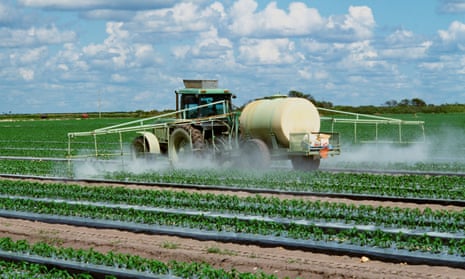People of color and low-income communities are at disproportionate risk of pesticide exposure, a new study has found.
Roughly 90% of pesticide use in the US is in agriculture, making farmworkers – 83% of whom identify as Hispanic – more vulnerable to the synthetic chemicals intended to kill, repel or control pests.
“These workers somehow are seen as expendable,” said Robert Bullard, a co-author of the report and the director of the Bullard Center for Environmental and Climate Justice at Texas Southern University. “This study shows the systemic neglect that [led to] a whole workforce being an underclass and not given the same weight when it comes to health and safety.”
The study reviewed CDC and EPA data, along with existing pesticide research, and found that structural injustices, gaps in regulation and weak farmworker protections have led to disproportionate exposure to pesticides among people of color. It was conducted by the Center for Biological Diversity; researchers from Historically Black Colleges and Universities; and advocates from farmworker, racial justice and conservation groups.
Twelve out of 14 markers for harmful pesticides, tracked over the past 20 years, were found in the blood and urine of Black and Mexican Americans at levels up to five times higher than those found in white Americans.
Pesticide safety laws in place today by the Environmental Protection Agency set standards for pesticide exposure among consumers through food, but they specifically exclude farmworker protection from occupational exposure. “Laws and regulatory practices that we have in place right now are really perpetuating this,” said Nathan Donley, environmental health science director at the Center for Biological Diversity and co-author of the report.
Jeannie Economos, pesticide safety and environmental health project coordinator at the Farmworker Association of Florida, said: “We need to get rid of these pesticides and find alternatives. They’re not only poisoning farmworkers, they are in our groundwater, on our food, and depleting our soil.”
Marginalized communities are at a higher rate of exposure both in the workplace and at home, whether due to proximity to a pesticide manufacturing plant or from use inside residences.
In California, Louisiana, Georgia, South Carolina, Tennessee, Arkansas and Missouri, people of color make up about 38% of the population. But that same group comprises 63% of the population living within a mile of one of 31 pesticide facilities that, as of November, the EPA deemed in “significant violation” of environmental laws such as the Clean Air Act and Clean Water Act.
The study also shows that pesticide use against rodents and cockroaches is often high in lower-income housing, due to age of buildings, poor maintenance and often crowded living conditions. In New York state, according to a study from 2002, 80% of low-income public housing facilities regularly applied pesticide. In another study from that year, 30% of pregnant African American and Dominican women in New York City were found to have at least eight pesticides detected in a home air-monitoring study.
Bullard said the problem extends to not only federally subsidized housing, but also rental units in large complexes occupied by “renters who have no control over how much pesticide is being used and the safety applied”.
Exposure to pesticides has been shown to negatively affect children’s development, and can lead to learning disabilities and behavioral problems.
In November, Senator Cory Booker introduced the Protect America’s Children from Toxic Pesticides Act, which would ban some of the most damaging pesticides, including neonicotinoids, which are banned in the European Union and significantly restricted in Canada. More than 350 organizations that use pesticides, including agricultural groups and golfing associations, sent a letter to Congress in opposition to the bill.
